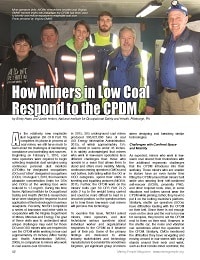Mining Publication: How Miners in Low Coal Respond to the CPDM
Original creation date: April 2017
Authors: EJ Haas, JE Helton
As the relatively new respirable dust regulation (30 CFR Part 70) completes its phase-in process at coal mines, we still have much to learn about the challenges of maintaining compliance and controlling dust sources. Beginning on February 1, 2016, coal mine operators were required to begin collecting respirable dust samples using continuous personal dust monitors(CPDMs) for designated occupations (DO) and “other” designated occupations (ODO). On August 1, 2016, the maximum allowable concentration limits for DOs and ODOs at the working face were reduced to 1.5 mg/m3. During this time frame, National Institute for Occupational Safety and Health (NIOSH) researchers have been studying the response to and application of this technology from various viewpoints. Recently, NIOSH completed a series of low-seam coal mine visits in cooperation with the Virginia Department of Mines, Minerals and Energy. The goal of these visits was to understand what unique challenges may exist for those DO and ODO miners who are required to use the CPDM while working in low coal (approximately 43 inches), in comparison to miners who work in coal seams over 60 inches.
